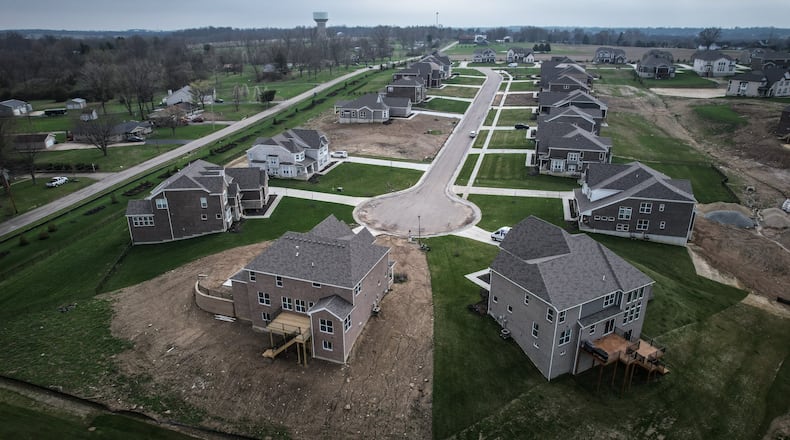According to U.S. Census data, Ohio’s population dropped by 0.4% from the 2020 Census to the 2022 estimates, and that would be a new trend. While Ohio’s population growth has slowed in recent decades, the total has not actually dropped from one formal 10-year Census to the next in at least 100 years.
Ohio’s population is projected to grow less than 1% over the next 30 years, according to Robert Graham, senior research scholar and associate director of the Scripps Gerontology Center at Miami University in Oxford.
“The state is shifting older. By 2025, more than one in four Ohioans will be age 60 and older” he said. “(The latest population estimate) really was not what we expected. We were projecting what the older population would be in 2020 but it missed the target, and the reason was COVID-19.”
The COVID-19 pandemic caused a higher death rate among older people. Graham described the latest numbers as “a population blip.”
Differences in parts of the state
Census data says areas near large cities grew fastest in Ohio from the 2020 Census to the 2022 estimates. Other than Warren County, which grew 3.07%, the other highest percentage population gains were all in counties surrounding Columbus — Union (6.54%), Delaware (5.69%), Pickaway (2.54%) and Fairfield (2.50%).
Graham said some metro areas are seeing population increases because they tend to attract younger people, plus job growth that increases the likelihood of larger population. He also said that land availability, new housing developments, more yard space and green space make these areas more attractive.
“People want access to metro areas and a better quality of life,” he said.
Graham said the greater Columbus region is growing thanks to a large, thriving Ohio State University, as well as major economic development wins on the edges of the region. Projects like the new Intel plant to the northeast of Columbus and the Honda manufacturing facility to the southwest trigger both direct and indirect job creation.
Cuyahoga County, which includes the city of Cleveland, was the only large metro county in the state’s top five for population decreases the past two years, at 2.28%. The other counties experiencing big drops are all in south-central and southeastern Ohio — Athens (-5.51%), Lawrence (-2.72%), Scioto (-2.46%) and Vinton (-1.87%).
Alison Goebel, executive director of the Greater Ohio Policy Center, said workforce will be a key factor because many industries are diverse.
“A place with a 2% population loss won’t be put out of the running,” she said. “Ohio needs parallel policies to address fast-growth areas such as the Columbus region and to support ‘legacy communities’ who are not in growth mode. Ohio has a lot of assets depending on the needs of industry.”
Goebel said communities not making investments in developing quality of life amenities will give companies or employees fewer incentives to attract or retain people to stay. In addition, concerns are raised about improving infrastructure in areas where there are population declines.
State working on incentives
Ohio’s next two-year budget, which is currently being negotiated by state legislators, includes several initiatives to attract people to Ohio.
One is the All Ohio Future Fund, targeting talent and workforce attraction, according to Megan Nagy, a public information officer for the Ohio Department of Development.
The proposed new Governor’s Merit Scholarship would provide $5,000 scholarships to every student in the top 5% of their high school graduating class who chooses to attend an Ohio college or university. The goal is to reduce the number of college students attending out-of-state schools by 10% to 15%.
Credit: Marshall Gorby
Credit: Marshall Gorby
Nagy said Gov. Mike DeWine has worked with legislators to invest $500 million in transformative projects in Ohio’s 32 Appalachian counties to develop new technology infrastructure, educational opportunities, and improved quality of life to keep people in Appalachia and attract new residents. She said Ohio has invested $1 billion in broadband expansion, infrastructure and brownfield remediation that will attract new businesses to the state.
She said state leadership is working hard to promote Ohio as a great place for many things — to visit, to pursue an education, to start and raise a family, and to work and do business.
“Migration is key to population growth,” Nagy said. “We need to attract people to come to Ohio.”
A county-by-county look at the region
* Warren County more than doubled in population from 1990-2020, from 113,000, to 242,000. After explosive growth years ago (39% in the 1990s, 34% in the 2000s), the rate has slowed some (14% in the 2010s), but is still among the fastest in Ohio. The 2022 estimate put it just shy of a quarter-million, at 249,778.
* Miami County grew by 3-6% each of the past three decades, and the 2022 Census estimates put it as the second-fastest growing county in the Dayton area the past two years (1.35%), climbing to 110,247.
* Butler County added roughly 100,000 people from 1990 to 2020, reaching 390,000. But that growth rate has been slowing — 14% in the 1990s, 10% in the 2000s and 6% in the 2010s. The new estimates suggest Butler County actually lost 0.5% of its population from 2020 to 2022, falling to 388,420.
* Greene County has been on a similar population trajectory as Butler County, growing by 8% in the 1990s and 9% in the 2000s, but then only 4% in the 2010s, according to Census data. The 2022 estimates show the county up by a narrow 0.3% the past two years, to 168,456.
* Montgomery County has been more up-and-down, with population declining 2.6% from 1990-2000, and dropping 4.3% from 2000-10, but then growing 0.4% in the 2010s. The new estimates suggest a 0.6% drop the past two years, to 533,892.
* Other counties: Clark County and Darke County, which have both shrunk every decade since at least 1990, are listed as down 0.8% and 0.7% respectively the past two years. Preble County, whose population last grew in the 1990s, is down 1% from 2020-22. Champaign County shows almost no change the past two years, with the 2020 full Census at 38,707 and the 2022 estimate up two people at 38,709.
Population of Dayton-area counties
| County | 1990 | 2020 | 2022 | 1990-2022 change | 2020-22 change |
|---|---|---|---|---|---|
| Montgomery | 573,809 | 537,316 | 533,892 | -6.96% | -0.64% |
| Butler | 291,479 | 390,378 | 388,420 | 33.26% | -0.50% |
| Warren | 113,909 | 242,338 | 249,778 | 119.28% | 3.07% |
| Greene | 136,731 | 167,971 | 168,456 | 23.20% | 0.29% |
| Clark | 147,548 | 135,973 | 134,831 | -8.62% | -0.84% |
| Miami | 93,182 | 108,777 | 110,247 | 18.31% | 1.35% |
| Darke | 53,619 | 51,883 | 51,529 | -3.90% | -0.68% |
| Clinton | 35,415 | 42,022 | 41,964 | 18.49% | -0.14% |
| Preble | 40,113 | 40,998 | 40,596 | 1.20% | -0.98% |
| Total | 1,485,805 | 1,717,656 | 1,719,713 | 15.74% | 0.12% |
About the Author




